There’s a lot to consider when buying strings for your guitar: what string gauge do you need? What material should they be made from? Do you need round wound or flat wounds?!
It can be overwhelming, especially when you’re just getting started with learning the guitar. I remember it well. You don’t want to spend hours trawling through endless product specifications and reviews, worrying that you might end up buying the wrong set of strings.
You just want to sit down and play a guitar with strings that sound great, feel great, all at a wallet-friendly price.
During my 15 years of playing guitar, I’ve gone through more than my fair share of strings. And during this time, I’ve made an active effort to try out as many different gauges, designs, and materials as I can.
I’ve written this article to condense my 15 years worth of experience into one quick and simple guide that not only gives you my personal recommendation (found here on Amazon), but also teaches you exactly what to look for when buying guitar strings.
Affiliate disclaimer: This page contains affiliate links for products that I’ve tried and tested. As an Amazon Associate I earn from qualifying purchases at no additional cost to you. Learn more here.
Best electric guitar strings for beginners
I’m confident in recommending Ernie Ball Super Slinky’s as the best guitar strings for a beginner. These Super Slinky’s are super reliable, super cost effective, and super popular! Seriously. Just take a look at the list of the iconic guitarists that use Ernie Ball strings.
As the name suggests, the lower string gauge means that these strings are a lot more flexible and will help beginners to naturally build finger strength and calluses. But, they’re not too flexible, so there’s no risk of any chords wobbling out of tune.
Not only are they one of the best, but Ernie Ball strings are also one of the most affordable strings there are. So, if an accident happens and a string breaks, it won’t break your bank to replace it!

These round wound, nickel-plated strings have a bright, snappy tone that’s perfect for pretty much any genre of music. From rock to pop, blues to metal, jazz to country – these strings can handle any genre. Sure, there might be some strings that naturally sound better for certain genres (more on that shortly), but if you’re looking for a quick, simple, and affordable solution that sounds great, then the Ernie Ball Super Slinky’s are for you.
Once you’ve got your new strings, check out my easy to follow guide on how to restring your electric guitar.
How to choose guitar strings
I don’t want to just give you my personal recommendation: I want to help you learn what you need to look for when buying guitar strings in the future.
So, I’ve put together this buyers guide that breaks down exactly what you need to know, what to expect, and what you might want to avoid!
Brand
Let’s start with the brands. Like with most things, brand names are a helpful way of knowing which guitar string manufacturers are reputable and reliable. After all, you don’t want to buy something that will break after just two strums!
Ernie Ball and D’Addario are by far the biggest players in the guitar string market. They’re the go-to brands for a lot of guitarists, professional and beginners alike. Think of your favorite guitar hero: there’s a very good chance that they use Ernie Ball or D’Addario strings.
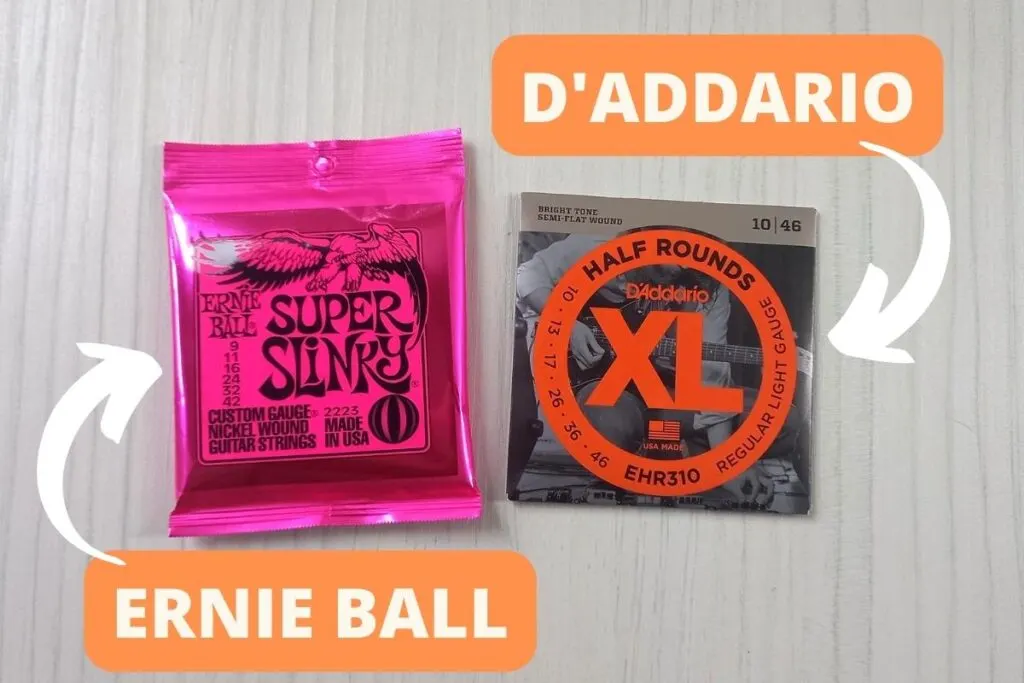
They’re also the strings that I use on my guitars. As I said earlier, I’ve gone through a lot of packs of strings over the years, both playing live and at home, and haven’t had a bad experience with either of these brands.
They consistently sound great, feel great, hold their tuning, and last a long time.
While they’re the most popular brands, they’re not the only guitar strings around. Depending on your needs, other trustworthy brands like DR Strings, Dunlop, Elixir, Fender, GHS, and Rotosound offer a wide variety of guitar strings that you can’t go wrong with.
String gauge
The next thing you’ll want to look at when buying guitar strings is the string gauge. I’ve written a full article on string gauge, that I really recommend checking out.
Very simply put, string gauge tells you how thick the guitar strings are.
Lighter gauge strings are much better for beginners as they need less pressure to fret notes on the fretboard. Also, if you’re going to be bending your strings, then you’ll want to use lighter gauge strings.
This isn’t only more comfortable on your hands, but it helps you to build up finger strength over time. Think of it like weights – it’s a lot better to start small before using the heavy weights!
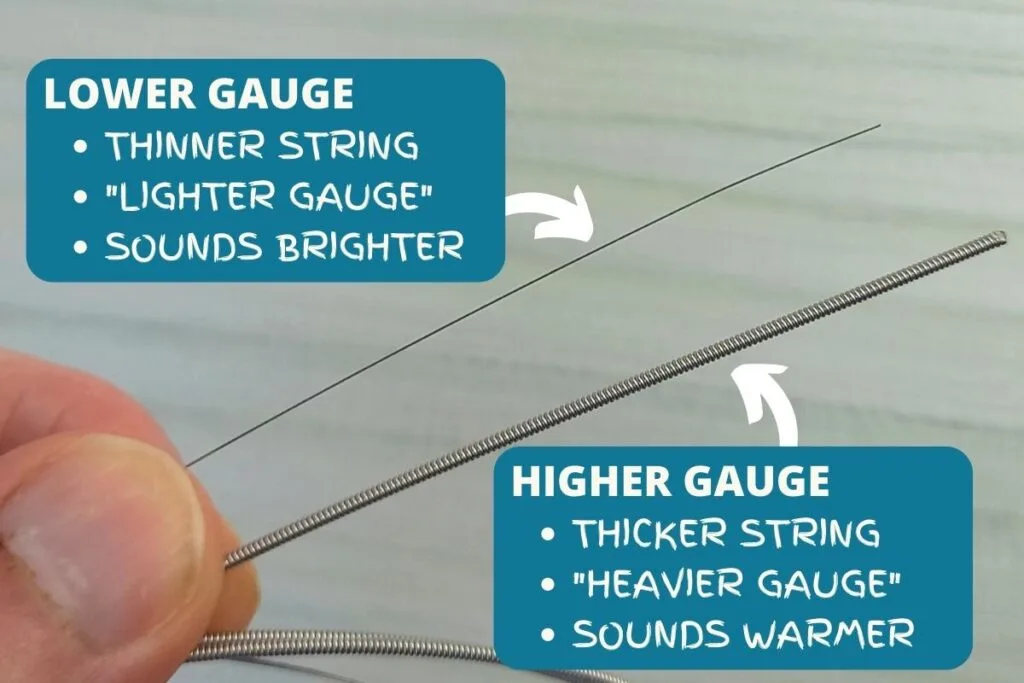
String gauge also affects the sound of your strings. Lighter strings sound brighter, with more high-end frequencies. Thicker strings, however, sound more bass-heavy.
That being said, if you’re going to be jamming in a lower tuning than standard (EADGBe) then you might want to go thicker to avoid floppy strings and fret buzz. Again, I’ve covered everything you need to know about string gauge in this article.
For beginners, I recommend starting with a string gauge of 9. This gives enough flexibility to the string to make them easier on your hand, while not being too bendy, which means that chords will stay in tune.
Materials
It’s important to know what material your guitar strings are made from, as different materials will make different sounds.
Now, each set of guitar strings comes with both wound and plain strings. Wound strings are formed of a core wire, and a wire that wraps around it to make it thicker. Plain strings are just a single piece of string. The lower strings (EAD) will be wound, and the higher strings (GBe) will be plain. Most of the time, the G string is plain, but it comes wound in some packs.
I’ve covered this in a lot more detail in my article on what guitar strings are made from.
The plain strings will always be made of some kind of steel alloy, no matter which guitar pack you buy.
The material shown on the packet (e.g. “nickel”) is referring to the wire that wraps around the wound strings.
Nickel-wound strings are the most common type of guitar string, and are best for beginners as they have a “standard” sound. Not too bright, not too mellow.
Other materials like pure-nickel, stainless steel, cobalt, monel, and more are available, but they’ll each change the tone of your guitar. This might be exactly what you’re looking for. Again, check out my article for a more in-depth look.
Winding type
The last thing to look at is the type of winding that the wound strings use. There’s three types: round wound, flat wound, and half wound.
Round wound is the most common type of winding used, and definitely my recommendation for beginner guitarists. It gives a bright but balanced sound that suits pretty much any genre of playing. If you’ve already got a guitar, I’m 99% certain that it has round wound strings on it now.
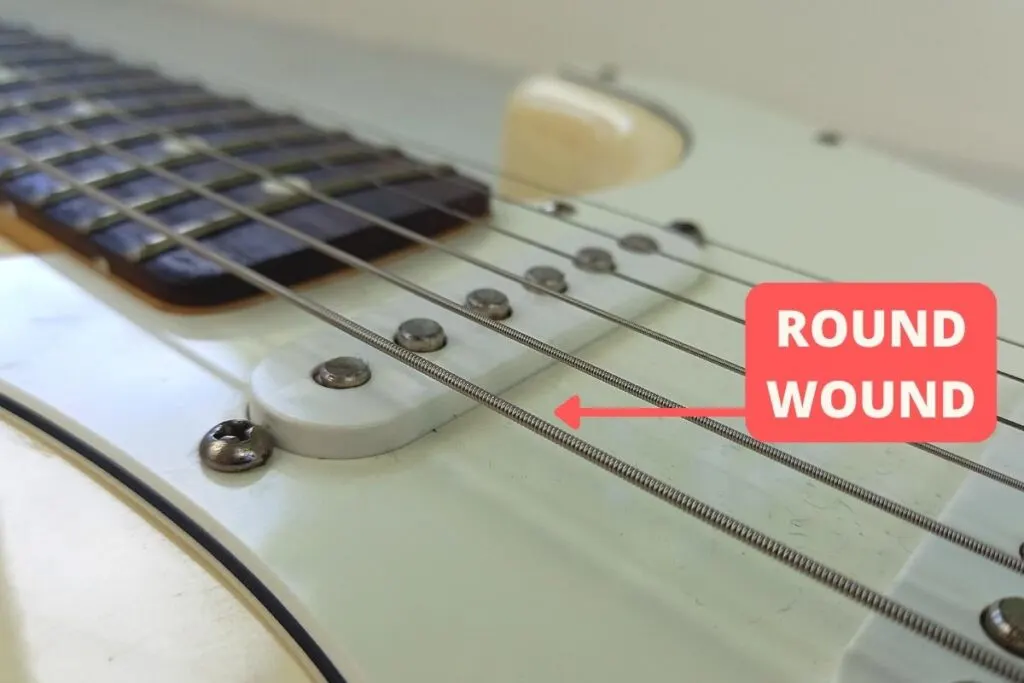
Flat wound strings have a much mellower and warmer tone than round wound strings, and half wound strings sit somewhere in between the two. These types of winding do last longer than round wound strings, but I see them as specialist strings that are best for jazz and blues players (blues, not blues rock!).
Again, I’ve covered the full ins-and-outs of each type fully in this article.
How often do you need to change your strings?
Guitar strings don’t last forever, and sooner or later you’re going to need to change them out for a new set.
The amount of mileage you’ll get out of your strings varies greatly on how much you play, how clean you keep your guitar, and other factors like how you store it.
You can get a lot more life out of your strings by giving them a quick wipe-down after playing. I use GHS Fast Fret to wipe off sweat and any other nasty grime that would otherwise ruin my strings.
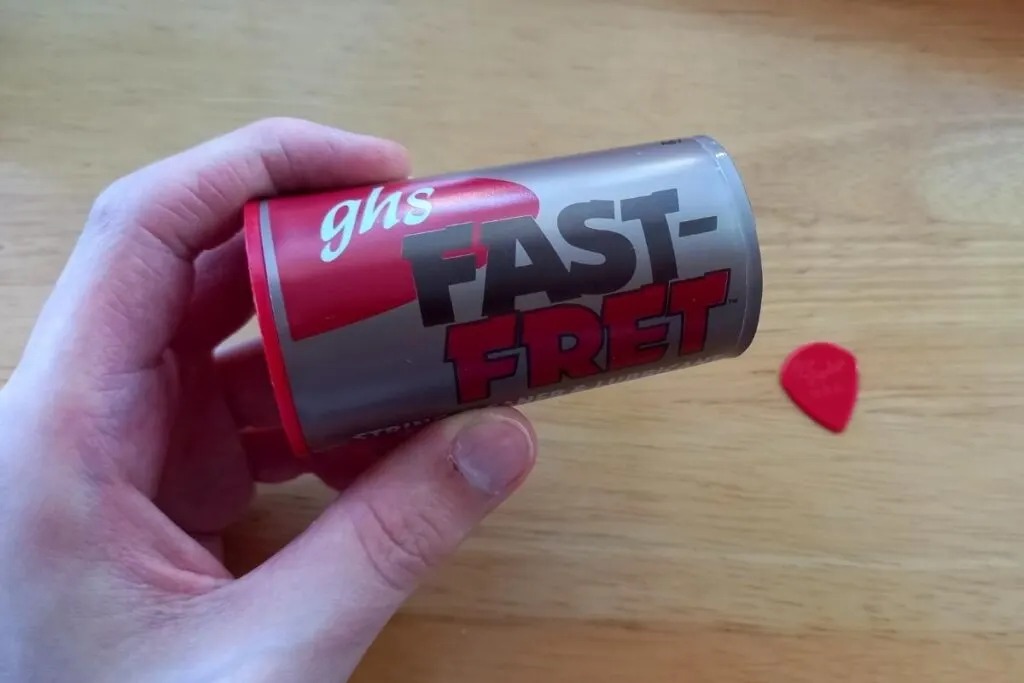
As I said, the amount of time your strings last varies drastically but as a very (very!) general rule, you can expect your strings to last around three months with regular playing.
But, learning to see the signs of wear is incredibly important to making sure that you’re changing your strings at the right time. I’ve written a list of 7 signs that it’s time to change your strings that you need to be aware of (and some tips on how to make them last longer!)
Best strings for specific genres
In most cases, a set of Ernie Ball Super Slinky’s will be the best choice for you. They’re my top pick for beginners as they can easily handle a wide range of tunings, and playing styles. That being said, I’ve included some specific examples below where you might want to try out alternative strings
Metal
If you’re going to be dropping your tuning and chugging your guitar, you’re going to need strings that are slightly thicker to handle the lower tuning, meaning that you’ll need heavier gauge strings.
In this case, I recommend trying Ernie Ball “Not Even Slinky” strings. They’re the strings I use on my Les Paul that’s reserved for metal playing. You can listen to difference between drop C using gauge “normal” strings (gauge 10) and the “Not Even Slinky” string in my article on the best guitar strings for drop C.
These chunky strings will be harder against your hands, but dropping the tuning will make them slightly less tight than in standard tuning.
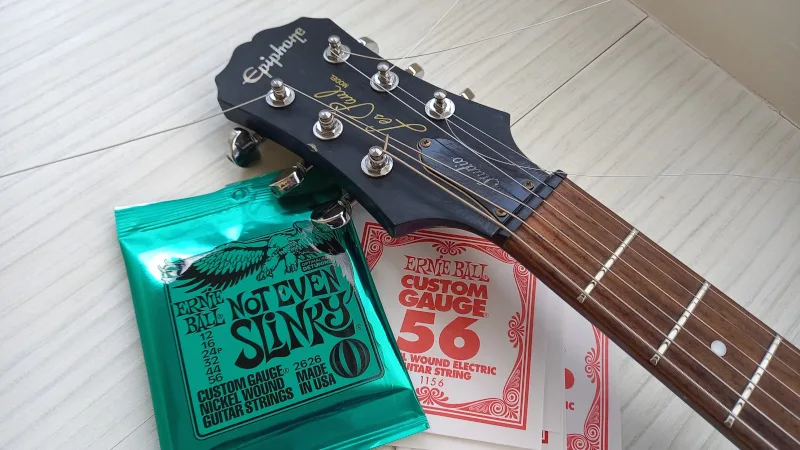
Jazz
Jazz is known for its warm, buttery smooth guitar tones. Sure, you can play jazz on any guitar string, but using strings that are specifically designed for jazz will get you even closer to the dry, woody tones of Wes Montgomery and Grant Green.
If this is what you’re looking for, you’ll want flat wound strings. Flat wounds will give you the quintessentially mellow jazz tone that’s less bright than their round wound counterparts and perfect for jazz.
I recommend using D’Addario XL Chromes Flat Wound, gauge 11. As they’re flat wound, and a higher gauge than I’d usually recommend for beginners, they will feel quite stiff. But, that’s the trade off you’ll have to make if you’re wholeheartedly set on the jazz tone!
You can check them out here on Amazon.
Related questions


Conor is a music producer, multi-instrumentalist, and all-round enthusiast from the UK with over 15 years of experience. He’s the founder and sole-content creator for the roundtable audio blog and YouTube channel.
